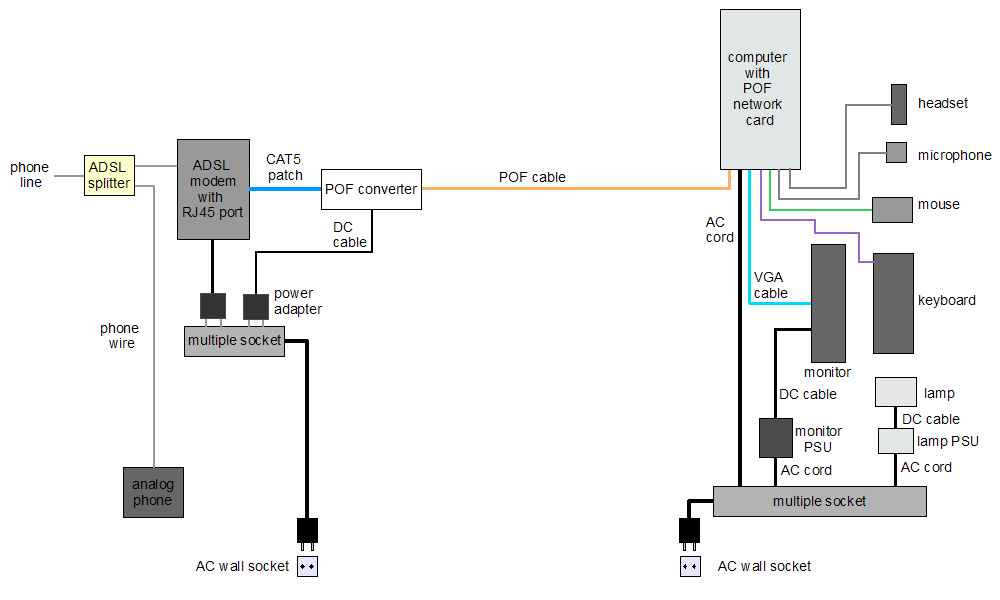Using Plastic Optical Fiber to stop electromagnetic radiation from ADSL
Introduction
In many homes today the Internet connection is of ADSL type, which is based on the same copper wire of the old analog phone. ADSL has a lot of electromagnetic emissions from the wire, from the modem and from the splitter filter that is needed for the analog phone. This electromagnetic radiation escapes from the devices and their cables and hits people that stay near there for some time. Some electromagnetic radiation is guided by the USB or Cat5 cable into the computer and from there it goes to the user interface peripherals like monitor, keyboard, mouse, microphone and headphones. This is a serious problem that, as usual, has been overlooked and ignored by industries and regulatory authorities, for the usual reasons of selling products or services.
We have been searching for ways to reduce the electromagnetic radiation of the ADSL modem and related wires for years. This year we have found a solution that is much better of all the previous ones. We have found that a good way to stop this electromagnetic radiation from going into the computer, monitor and other user interface peripherals is to use an optical fiber between the modem and the computer. In particular we can use Plastic Optical Fiber which is robust and easy to install.
We tried all the three different types of products available to connect a computer to a POF cable, and we concluded that the only acceptable solution in terms of electromagnetic emissions is the POF network card inside the computer, so, in the following we suppose that all computers are provided with a network card for POF. On the side of the ADSL modem instead we have to use some POF converters because there are no ADSL modems with POF cards embedded.
Example with a single computer
A single computer connected to the Internet through an ADSL modem with one LAN port can be rearranged in this way:

In this way the electromagnetic waves coming from the ADSL, or generated by the modem, can't go into the computer. However, near the ADSL cable we have a lot of things: the ADSL modem, the ADSL filter, the phone wire from the filter to the modem, the phone wire from the filter to the analog phone, the POF media converter, the power adapter of the POF converter, the Cat5 patch between the modem and the POF converter, the power adapter of the modem. All these devices and cables emit a lot of electromagnetic radiation, so it is very important that all these devices are enclosed in a suitable metal box that shields most of the EM radiation.
Connection for multiple computers
For having multiple independent computers that can access the Internet through the same ADSL we have to use a modem that is also a LAN router, or we have to attach the ADSL modem to a LAN router. Supposing that the modem is also a router we have the modem-router and its power adapter, the ADSL splitter filter, the phone wire from the filter to the modem, the phone wire from the filter to the phone, and a number of POF media converters, one for each computer to serve, each with a piece of Cat5 cable between the POF converter and the router, and each with its own power adapter. If the modem is not also a router, then we have also a separate router with its power adapter, and a piece of Cat5 cable between the modem and the router. All these electronic devices and cables create a lot of electromagnetic emissions and so they should be enclosed in a shielding box, or moved to a separate room. However there is no electric wire between the ADSL modem and the computers so if the computers are far enough from the modem they don't get any EMR due to the modem or the ADSL. The only problem is the EMR that goes through space, and this has to be blocked with a suitable shielding around the modem and the other devices.
Related pages
Plastic Optical Fiber ADSL box project
Plastic Optical Fiber conclusions
Plastic Optical Fiber page list